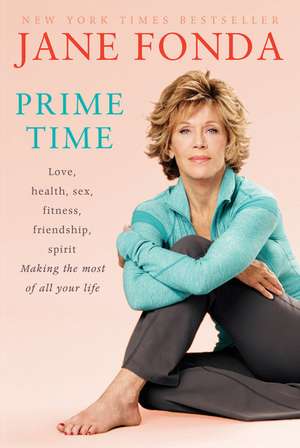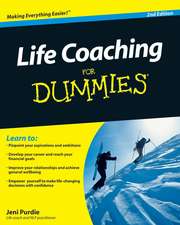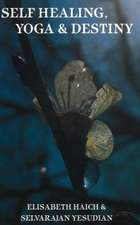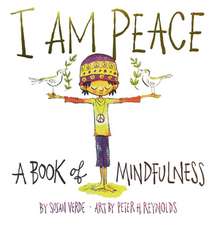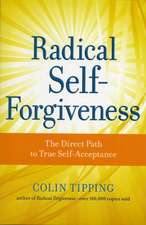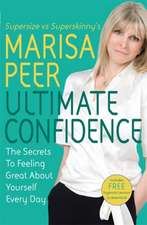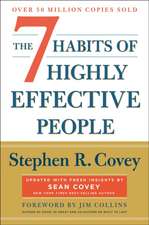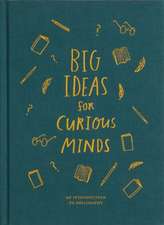Prime Time: Making the Most of All of Your Life
Autor Jane Fondaen Limba Engleză Paperback – 30 apr 2012
Vezi toate premiile Carte premiată
Audies (2012)
An A-to-Z guide to living and aging well by #1 bestselling author, actress, and workout pioneer Jane Fonda
In this unique, candid, and inspiring book, Jane Fonda explores how midlife and beyond can be the time when we become our most energetic, loving, and fulfilled selves. Highlighting new research and sharing stories from her own life and from the lives of others, she outlines the 11 key ingredients to vitality—from exercise and diet, to forging new pathways in the brain, to loving, staying connected, and giving of oneself. She explains how performing a life review helped her clarify goals and move ahead, and shows how we can do this too. In Prime Time, Jane Fonda offers an empowering vision for how to live your best life, for all of your life.
Preț: 122.68 lei
Nou
Puncte Express: 184
Preț estimativ în valută:
23.48€ • 25.52$ • 19.74£
23.48€ • 25.52$ • 19.74£
Carte indisponibilă temporar
Doresc să fiu notificat când acest titlu va fi disponibil:
Se trimite...
Preluare comenzi: 021 569.72.76
Specificații
ISBN-13: 9780812978582
ISBN-10: 0812978587
Pagini: 416
Ilustrații: PHOTOS, ILLUSTRATIONS
Dimensiuni: 161 x 232 x 25 mm
Greutate: 0.61 kg
Editura: Random House Trade
ISBN-10: 0812978587
Pagini: 416
Ilustrații: PHOTOS, ILLUSTRATIONS
Dimensiuni: 161 x 232 x 25 mm
Greutate: 0.61 kg
Editura: Random House Trade
Notă biografică
Jane Fonda is an Oscar- and Emmy-winning actress and highly successful producer. She revolutionized the fitness industry with the Jane Fonda Workout in 1982 and has sold more than seventeen million copies of her fitness-focused books, videos, and recordings. She is involved with several causes and is the founder of both the Georgia Campaign for Adolescent Pregnancy Prevention and the Jane Fonda Center at Emory University. She is the author of the #1 New York Times bestseller My Life So Far, and she received a Tony nomination in 2009 for her role in 33 Variations. She lives in Los Angeles.
From the Hardcover edition.
From the Hardcover edition.
Extras
PREFACE
The Arch and the Staircase
The past empowers the present, and the groping
footsteps leading to this present mark the pathways
to the future.
—Mary Catherine Bateson
Several years ago, i was coming to the end of my sixties
and facing my seventies, the second decade of what I thought of as
the Third Act of my life— Act III, which, as I see it, begins at age
sixty. I was worried. Being in my sixties was one thing. Given good
health, we can fudge our sixties. But seventy—now, that’s serious.
In our grandparents’ time, people in their seventies were considered
part of the “old old” . . . on their way out.
However, a revolution has occurred within the last century—
a longevity revolution. Studies show that, on average, thirty- four
years have been added to human life expectancy, moving it from an
average of forty- six years to eighty! This addition represents an
entire second adult lifetime, and whether we choose to confront it
or not, it changes everything, including what it means to be human.
Adding a Room
The social anthropologist (and a friend of mine) Mary Catherine
Bateson has a metaphor for living with this longer life span in view.
She writes in her recent book Composing a Further Life: The Age of Active
Wisdom, “We have not added decades to life expectancy by simply
extending old age; instead, we have opened up a new space partway
through the life course, a second and different kind of adulthood
that precedes old age, and as a result every stage of life is undergoing
change.” Bateson uses the identifi able metaphor of what happens
when a new room is added to your home. It isn’t just the new
room that is different; every other part of the house and how it is
used is altered a bit by the addition of this room.
In the house that is our life, things such as planning, marriage,
love, fi nances, parenting, travel, education, physical fi tness, work,
retirement—our very identities, even!—all take on new meaning
now that we can expect to be vital into our eighties and nineties
. . . or longer.
But our culture has not come to grips with the ways the longevity
revolution has altered our lives. Institutionally, so much of how
we do things is the same as it was early in the twentieth century,
with our lives segregated into age- specifi c silos: During the fi rst
third we learn, during the second third we produce, and the last
third we presumably spend on leisure. Consider, instead, how it
would look if we tore down the silos and integrated the activities.
For example, let’s begin to think of learning and working as a lifelong
challenge instead of something that ends when you retire.
What if the wonderfully empowering feeling of being productive
can be experienced by children early in life, and if they know from
fi rst grade that education will be an expected part of their entire
lives? What if the second, traditionally productive silo is braided
with leisure and education? And seniors, with twenty or more productive
years left, can enjoy leisure time while remaining in the
workforce in some form and attending to education if for no other
reason than to challenge their minds? Envisioned this way, longevity
becomes like a symphony with echoes of different times recurring
with slight modifi cations, as in music, across the life arc.
Except that we don’t have the sheet music to this new symphony.
We— today’s boomers and seniors— are the pioneer generations,
the ones who need to compose together a template for how
to maximize the potential of this amazing gift of time, so as to
become whole, fully realized people over the longer life arc.
In attempting to chart a course for myself into my sixties and
beyond, I’ve found it helpful to view the symphony of my own life
in three acts, or three major developmental stages: Act I, the fi rst
three decades; Act II, the middle three decades; and Act III, the
fi nal three decades (or however many more years one is granted).
As I searched for ways to understand the new realities of aging,
I discovered the arch and the staircase.
The Arch and the Staircase
Here you see two diagrams that I have had drawn, because they
make visualizable two conceptions of human life that have come to
mean a lot to me.
One diagram, the arch, represents a biological concept, taking
us from childhood to a middle peak of maturity, followed by a
decline into infi rmity.
The other, a staircase, shows our potential for upward progression
toward wisdom, spiritual growth, learning— toward, in other
words, consciousness and soul.
The vision behind these diagrams was developed by Rudolf Arnheim,
the late professor emeritus of the psychology of art at Harvard
University, and for me they are clear metaphors for ways we can choose
to view aging. Our youth- obsessed culture encourages us to focus
on the arch—age as physical decline— more than on the stairway— age
as potential for continued development and ascent. But it is the stairway
that points to late life’s promise, even in the face of physical
decline. Perhaps it should be a spiral staircase! Because the wisdom,
balance, refl ection, and compassion that this upward movement represents
don’t just come to us in one linear ascension; they circle around
us, beckoning us to keep climbing, to keep looking both back and
ahead.
Rehearsing the Future
Throughout my life, whenever I was confronted by something I
feared, I tried to make it my best friend, stare it in the face, and get
to know its ins and outs. Eleanor Roosevelt once said, “You gain
strength, courage, and confi dence by every experience in which you
really stop to look fear in the face.” I have found this to be true.
This is how I discovered that knowledge about what lies ahead can
empower me, help me conquer my fears, take the wind out of the
sails of my anxiety. Know thine enemy! Remember Rumpelstiltskin,
the evil dwarf in the Grimms’ fairy tale? He was destroyed
once the miller’s daughter learned his name and called it out. When
we name our fears, bring them out into the open, and examine
them in the light, they weaken and wither.
So, one of the ways I have tried to overcome my fears of aging
involved rehearsing for it. In fact, I started doing this in Act II. I
believe that this rehearsal for the future (along with doing a life
review of the past) is part of why I have been able— so far— to live
Act III with relative equanimity.
Being with my father when he was in his late seventies and in
decline due to heart problems was what began to shatter any childhood
illusions I’d had of immortality. I was in my mid- forties, and it
hit me that with him gone, I would be the oldest one left in the family
and, before too long, next at the turnstile. I realized then that it was
not so much the idea of death itself that frightened me as it was being
faced with regrets, the “what if”s and the “if only”s when there is no
time left to do anything about them. I didn’t want to arrive at the end
of the Third Act and discover too late all that I had not done.
I began to feel the need to project myself into the future, to
visualize who I wanted to be and what regrets I might have that I
would need to address before I got too old. I wanted to understand
as much as possible what cards age would deal me; what I could
realistically expect of myself physically; how much of aging was
negotiable; and what I needed to do to intervene on my own behalf
with what appeared to be a downward slope.
The birth of my two children had taught me the importance of
knowledge and preparation. The fi rst birth had been a terrifying,
lonely experience; I went through it unprepared and unrehearsed,
swept along passively in a sea of pain. The second birth was quite
the opposite. My husband and I worked with a birth educator in
the months leading up to my due date, so that I was able to visualize
what would happen and know what to do. The physical ordeal
was no less grueling, the process no faster, but the experience itself
was transformed. With knowledge and rehearsal, I found it easier
to ride atop the sequence of events rather than be totally submerged
by the pain.
I brought what I’d learned from childbirth to my experience
facing late midlife. As I said, I was scared back then— it is hard to
let go of children, of the success that came with youth, of old identities
when new ones aren’t yet clearly defi ned. I felt I could choose
whether to be blindly propelled into later life, in denial with my
eyes wide shut, or I could take charge and seek out what I needed
to know in order to make informed decisions in the many changing
areas of my life. That’s why, in 1984, at age forty- six, before I’d even
had my fi rst hot fl ash, I wrote Women Coming of Age, with Mignon
McCarthy, about what women can expect, physically, as they age,
and what parts of aging are negotiable. It was a way to force myself
to confront and rehearse the future. I was shocked to discover how
little research had been devoted to women’s health. Most medical
studies I found had been done on men. I’m happy to say this has
started to change.
At forty- six, I began to envision the old woman I wished to be,
and I described her in that book:
I see an old woman walking briskly, out- of- doors, in every
season. She’s feisty. She’s not afraid of being alone. Her face
is lined and full of life. There’s a ruddy fl ush to her cheeks
and a bright curious look in her eye because she’s still learning.
Her husband often walks with her. They laugh a lot. She
likes to be with young people and she’s a good listener. Her
grandchildren love to tell her stories and to hear hers because
she’s got some really good ones that contain sweet, hidden
lessons about life. She has a conscious set of values and the
knack to make them compelling to her young friends.
This is an example of rehearsing the future . . . good to do at any age!
I’m glad I wrote it down, because it’s fun for me to read my
forty- six- year- old vision of my senior self, almost thirty years later, as
a reality check to see how well I’m doing. Some days, I actually think
I’m doing pretty well. I’m still feisty, and my solitude (which I cherish)
doesn’t feel like loneliness. Humor has defi nitely come to the
fore. I’m no longer married, but I do walk together with my— what
to call the man I am with when I’m seventy- two and unmarried?
“Boyfriend” sounds too juvenile, don’t you think? So then, what?
“Lover?” That seems too in- your- face. I think I’ll go with “honey.”
Anyway, my honey and I walk together, we laugh a lot, and we try to
swing- dance for fi fteen or twenty minutes every night— when we
can. I feel I may have fi nally conquered my diffi culties with intimacy.
(Or maybe I just found a man who isn’t scared of it!)
Gerontologists such as Bernice Neugarten have learned from
their studies of the aged that traumatic events— widowhood,
menopause, loss of a job, even imminent death— are not experienced
as traumas “if they were anticipated and, in effect, rehearsed as
part of the life cycle.”
Betty Friedan, in her book The Fountain of Age, wrote, “The fi nding
emerges that the difference between knowing and planning,
and not knowing what to expect (or denial of change because of
false expectations) can be the crucial factor between moving on to
new growth in the last third of life, or succumbing to stagnation,
pathology, and despair.”
With the help of many friends of all ages, as well as gerontologists,
sexologists, urologists, biologists, psychologists, experts in
cognitive research and health care, and a physicist or two, I have
written this book. Even though I was already in my own Act III,
doing this has been a form of rehearsal— for myself and for you, the
reader. I wanted to be prepared and learn all I could. I wanted to
be able to say to myself and to you, “Let’s make the most of the
years that take us from midlife to the end, and here’s how!”
I do not want to romanticize the process of aging. Obviously,
there is no guarantee that this will be a time of growth and fruition.
There are negatives to any stage of life, including potentially serious
issues of mental and physical health. I cannot address all these
things within the scope of this book. As we know, some of how life
unfolds is a matter of luck. Some of it—about one- third, actually—
is genetic and beyond our control. The good news is that this means
that for a lot of it, maybe two- thirds of the life arc, we can do something
about how well we do.
This book is for those of us who, like me, believe that luck is
opportunity meeting preparation; that with preparation and knowledge,
with information and refl ection, we can try to raise the odds
of being lucky, and of making our last three decades— our Third
Acts— the most peaceful, generous, loving, sensual, transcendent
time of all; and that planning for it, especially during one’s middle
years, can help make this so.
Wholeness
Arnheim’s staircase made me realize how important it can be to see
life as an interplay between one’s beginning, middle, and end. I
found out that if we understand more deeply what Act I and Act II
are (or were) about, who we are (or were becoming) during those
foundational years, what dreams are still to be realized and which
regrets addressed, then we can see Act III as a coming to fruition,
rather than simply a period of marking time, or the absence of
youth. We can understand it not as the far side of the arch— as the
decline after the peak— but as a stage of development in its own terms.
We can experience it as part of the staircase— with its own challenges
and joys, pitfalls and rewards, a stage as evolving and as satisfying
and different from midlife or youth as adolescence is from
childhood.
In 1996, Erik and Joan Erikson wrote, in The Life Cycle Completed,
“Lacking a culturally viable ideal of old age, our civilization does
not really harbor a concept of the whole of life.”4 The old ways of
thinking about age, the fears of losing our youth and facing our
own mortality, have kept us from seeing Act III as a vital, inte-
grated part of our overall story, the potential- fi lled culmination of
the fi rst two acts. This old thinking is even more tragic now, in light
of the extension of the life span. It can rob us of wholeness, and it
can rob society of what we each, in our ripeness, have to offer.
Those of us now entering our Third Acts are, on the whole,
physically stronger and healthier than ever before. There is every
likelihood that, if we work at it individually and collectively, we can
develop a new “culturally viable ideal of old age” and see our lives as
a series of stages that build one upon the other. Our doing so will
not be just for us; it will represent a major cultural shift for the
world around us and will help younger generations reconceive of
their own life spans.
I have been inspired and encouraged by what I have learned
while writing this book. I hope reading it will do the same for you.
And so let’s begin.
From the Hardcover edition.
The Arch and the Staircase
The past empowers the present, and the groping
footsteps leading to this present mark the pathways
to the future.
—Mary Catherine Bateson
Several years ago, i was coming to the end of my sixties
and facing my seventies, the second decade of what I thought of as
the Third Act of my life— Act III, which, as I see it, begins at age
sixty. I was worried. Being in my sixties was one thing. Given good
health, we can fudge our sixties. But seventy—now, that’s serious.
In our grandparents’ time, people in their seventies were considered
part of the “old old” . . . on their way out.
However, a revolution has occurred within the last century—
a longevity revolution. Studies show that, on average, thirty- four
years have been added to human life expectancy, moving it from an
average of forty- six years to eighty! This addition represents an
entire second adult lifetime, and whether we choose to confront it
or not, it changes everything, including what it means to be human.
Adding a Room
The social anthropologist (and a friend of mine) Mary Catherine
Bateson has a metaphor for living with this longer life span in view.
She writes in her recent book Composing a Further Life: The Age of Active
Wisdom, “We have not added decades to life expectancy by simply
extending old age; instead, we have opened up a new space partway
through the life course, a second and different kind of adulthood
that precedes old age, and as a result every stage of life is undergoing
change.” Bateson uses the identifi able metaphor of what happens
when a new room is added to your home. It isn’t just the new
room that is different; every other part of the house and how it is
used is altered a bit by the addition of this room.
In the house that is our life, things such as planning, marriage,
love, fi nances, parenting, travel, education, physical fi tness, work,
retirement—our very identities, even!—all take on new meaning
now that we can expect to be vital into our eighties and nineties
. . . or longer.
But our culture has not come to grips with the ways the longevity
revolution has altered our lives. Institutionally, so much of how
we do things is the same as it was early in the twentieth century,
with our lives segregated into age- specifi c silos: During the fi rst
third we learn, during the second third we produce, and the last
third we presumably spend on leisure. Consider, instead, how it
would look if we tore down the silos and integrated the activities.
For example, let’s begin to think of learning and working as a lifelong
challenge instead of something that ends when you retire.
What if the wonderfully empowering feeling of being productive
can be experienced by children early in life, and if they know from
fi rst grade that education will be an expected part of their entire
lives? What if the second, traditionally productive silo is braided
with leisure and education? And seniors, with twenty or more productive
years left, can enjoy leisure time while remaining in the
workforce in some form and attending to education if for no other
reason than to challenge their minds? Envisioned this way, longevity
becomes like a symphony with echoes of different times recurring
with slight modifi cations, as in music, across the life arc.
Except that we don’t have the sheet music to this new symphony.
We— today’s boomers and seniors— are the pioneer generations,
the ones who need to compose together a template for how
to maximize the potential of this amazing gift of time, so as to
become whole, fully realized people over the longer life arc.
In attempting to chart a course for myself into my sixties and
beyond, I’ve found it helpful to view the symphony of my own life
in three acts, or three major developmental stages: Act I, the fi rst
three decades; Act II, the middle three decades; and Act III, the
fi nal three decades (or however many more years one is granted).
As I searched for ways to understand the new realities of aging,
I discovered the arch and the staircase.
The Arch and the Staircase
Here you see two diagrams that I have had drawn, because they
make visualizable two conceptions of human life that have come to
mean a lot to me.
One diagram, the arch, represents a biological concept, taking
us from childhood to a middle peak of maturity, followed by a
decline into infi rmity.
The other, a staircase, shows our potential for upward progression
toward wisdom, spiritual growth, learning— toward, in other
words, consciousness and soul.
The vision behind these diagrams was developed by Rudolf Arnheim,
the late professor emeritus of the psychology of art at Harvard
University, and for me they are clear metaphors for ways we can choose
to view aging. Our youth- obsessed culture encourages us to focus
on the arch—age as physical decline— more than on the stairway— age
as potential for continued development and ascent. But it is the stairway
that points to late life’s promise, even in the face of physical
decline. Perhaps it should be a spiral staircase! Because the wisdom,
balance, refl ection, and compassion that this upward movement represents
don’t just come to us in one linear ascension; they circle around
us, beckoning us to keep climbing, to keep looking both back and
ahead.
Rehearsing the Future
Throughout my life, whenever I was confronted by something I
feared, I tried to make it my best friend, stare it in the face, and get
to know its ins and outs. Eleanor Roosevelt once said, “You gain
strength, courage, and confi dence by every experience in which you
really stop to look fear in the face.” I have found this to be true.
This is how I discovered that knowledge about what lies ahead can
empower me, help me conquer my fears, take the wind out of the
sails of my anxiety. Know thine enemy! Remember Rumpelstiltskin,
the evil dwarf in the Grimms’ fairy tale? He was destroyed
once the miller’s daughter learned his name and called it out. When
we name our fears, bring them out into the open, and examine
them in the light, they weaken and wither.
So, one of the ways I have tried to overcome my fears of aging
involved rehearsing for it. In fact, I started doing this in Act II. I
believe that this rehearsal for the future (along with doing a life
review of the past) is part of why I have been able— so far— to live
Act III with relative equanimity.
Being with my father when he was in his late seventies and in
decline due to heart problems was what began to shatter any childhood
illusions I’d had of immortality. I was in my mid- forties, and it
hit me that with him gone, I would be the oldest one left in the family
and, before too long, next at the turnstile. I realized then that it was
not so much the idea of death itself that frightened me as it was being
faced with regrets, the “what if”s and the “if only”s when there is no
time left to do anything about them. I didn’t want to arrive at the end
of the Third Act and discover too late all that I had not done.
I began to feel the need to project myself into the future, to
visualize who I wanted to be and what regrets I might have that I
would need to address before I got too old. I wanted to understand
as much as possible what cards age would deal me; what I could
realistically expect of myself physically; how much of aging was
negotiable; and what I needed to do to intervene on my own behalf
with what appeared to be a downward slope.
The birth of my two children had taught me the importance of
knowledge and preparation. The fi rst birth had been a terrifying,
lonely experience; I went through it unprepared and unrehearsed,
swept along passively in a sea of pain. The second birth was quite
the opposite. My husband and I worked with a birth educator in
the months leading up to my due date, so that I was able to visualize
what would happen and know what to do. The physical ordeal
was no less grueling, the process no faster, but the experience itself
was transformed. With knowledge and rehearsal, I found it easier
to ride atop the sequence of events rather than be totally submerged
by the pain.
I brought what I’d learned from childbirth to my experience
facing late midlife. As I said, I was scared back then— it is hard to
let go of children, of the success that came with youth, of old identities
when new ones aren’t yet clearly defi ned. I felt I could choose
whether to be blindly propelled into later life, in denial with my
eyes wide shut, or I could take charge and seek out what I needed
to know in order to make informed decisions in the many changing
areas of my life. That’s why, in 1984, at age forty- six, before I’d even
had my fi rst hot fl ash, I wrote Women Coming of Age, with Mignon
McCarthy, about what women can expect, physically, as they age,
and what parts of aging are negotiable. It was a way to force myself
to confront and rehearse the future. I was shocked to discover how
little research had been devoted to women’s health. Most medical
studies I found had been done on men. I’m happy to say this has
started to change.
At forty- six, I began to envision the old woman I wished to be,
and I described her in that book:
I see an old woman walking briskly, out- of- doors, in every
season. She’s feisty. She’s not afraid of being alone. Her face
is lined and full of life. There’s a ruddy fl ush to her cheeks
and a bright curious look in her eye because she’s still learning.
Her husband often walks with her. They laugh a lot. She
likes to be with young people and she’s a good listener. Her
grandchildren love to tell her stories and to hear hers because
she’s got some really good ones that contain sweet, hidden
lessons about life. She has a conscious set of values and the
knack to make them compelling to her young friends.
This is an example of rehearsing the future . . . good to do at any age!
I’m glad I wrote it down, because it’s fun for me to read my
forty- six- year- old vision of my senior self, almost thirty years later, as
a reality check to see how well I’m doing. Some days, I actually think
I’m doing pretty well. I’m still feisty, and my solitude (which I cherish)
doesn’t feel like loneliness. Humor has defi nitely come to the
fore. I’m no longer married, but I do walk together with my— what
to call the man I am with when I’m seventy- two and unmarried?
“Boyfriend” sounds too juvenile, don’t you think? So then, what?
“Lover?” That seems too in- your- face. I think I’ll go with “honey.”
Anyway, my honey and I walk together, we laugh a lot, and we try to
swing- dance for fi fteen or twenty minutes every night— when we
can. I feel I may have fi nally conquered my diffi culties with intimacy.
(Or maybe I just found a man who isn’t scared of it!)
Gerontologists such as Bernice Neugarten have learned from
their studies of the aged that traumatic events— widowhood,
menopause, loss of a job, even imminent death— are not experienced
as traumas “if they were anticipated and, in effect, rehearsed as
part of the life cycle.”
Betty Friedan, in her book The Fountain of Age, wrote, “The fi nding
emerges that the difference between knowing and planning,
and not knowing what to expect (or denial of change because of
false expectations) can be the crucial factor between moving on to
new growth in the last third of life, or succumbing to stagnation,
pathology, and despair.”
With the help of many friends of all ages, as well as gerontologists,
sexologists, urologists, biologists, psychologists, experts in
cognitive research and health care, and a physicist or two, I have
written this book. Even though I was already in my own Act III,
doing this has been a form of rehearsal— for myself and for you, the
reader. I wanted to be prepared and learn all I could. I wanted to
be able to say to myself and to you, “Let’s make the most of the
years that take us from midlife to the end, and here’s how!”
I do not want to romanticize the process of aging. Obviously,
there is no guarantee that this will be a time of growth and fruition.
There are negatives to any stage of life, including potentially serious
issues of mental and physical health. I cannot address all these
things within the scope of this book. As we know, some of how life
unfolds is a matter of luck. Some of it—about one- third, actually—
is genetic and beyond our control. The good news is that this means
that for a lot of it, maybe two- thirds of the life arc, we can do something
about how well we do.
This book is for those of us who, like me, believe that luck is
opportunity meeting preparation; that with preparation and knowledge,
with information and refl ection, we can try to raise the odds
of being lucky, and of making our last three decades— our Third
Acts— the most peaceful, generous, loving, sensual, transcendent
time of all; and that planning for it, especially during one’s middle
years, can help make this so.
Wholeness
Arnheim’s staircase made me realize how important it can be to see
life as an interplay between one’s beginning, middle, and end. I
found out that if we understand more deeply what Act I and Act II
are (or were) about, who we are (or were becoming) during those
foundational years, what dreams are still to be realized and which
regrets addressed, then we can see Act III as a coming to fruition,
rather than simply a period of marking time, or the absence of
youth. We can understand it not as the far side of the arch— as the
decline after the peak— but as a stage of development in its own terms.
We can experience it as part of the staircase— with its own challenges
and joys, pitfalls and rewards, a stage as evolving and as satisfying
and different from midlife or youth as adolescence is from
childhood.
In 1996, Erik and Joan Erikson wrote, in The Life Cycle Completed,
“Lacking a culturally viable ideal of old age, our civilization does
not really harbor a concept of the whole of life.”4 The old ways of
thinking about age, the fears of losing our youth and facing our
own mortality, have kept us from seeing Act III as a vital, inte-
grated part of our overall story, the potential- fi lled culmination of
the fi rst two acts. This old thinking is even more tragic now, in light
of the extension of the life span. It can rob us of wholeness, and it
can rob society of what we each, in our ripeness, have to offer.
Those of us now entering our Third Acts are, on the whole,
physically stronger and healthier than ever before. There is every
likelihood that, if we work at it individually and collectively, we can
develop a new “culturally viable ideal of old age” and see our lives as
a series of stages that build one upon the other. Our doing so will
not be just for us; it will represent a major cultural shift for the
world around us and will help younger generations reconceive of
their own life spans.
I have been inspired and encouraged by what I have learned
while writing this book. I hope reading it will do the same for you.
And so let’s begin.
From the Hardcover edition.
Recenzii
“Reassuring . . . upbeat . . . Prime Time is part autobiographical confessional, part life advice, the two intertwined, so that reading the book is often like talking to a friend.”—Los Angeles Times
“A how-to book about being happy and self-aware [that] cites research and interviews with upbeat, lively, sexually active older people to extract some all-purpose lessons about endurance.”—The New York Times
“Warm, informative, and incredibly life affirming.”—Woman’s Day
“Read this, age gracefully.”—InStyle
“A how-to book about being happy and self-aware [that] cites research and interviews with upbeat, lively, sexually active older people to extract some all-purpose lessons about endurance.”—The New York Times
“Warm, informative, and incredibly life affirming.”—Woman’s Day
“Read this, age gracefully.”—InStyle
Descriere
Descriere de la o altă ediție sau format:
Covering the 11 key ingredients for vital living, Fonda shows you how to enjoy a more insightful, healthy and fully integrated life - one that is profoundly in touch with yourself, your body, mind and spirit, and with your talents, friends and community.
Covering the 11 key ingredients for vital living, Fonda shows you how to enjoy a more insightful, healthy and fully integrated life - one that is profoundly in touch with yourself, your body, mind and spirit, and with your talents, friends and community.
Premii
- Audies Winner, 2012
